File Integrity Monitoring
What is FIM
File Integrity Monitoring (FIM) is a tool that monitors files and alerts you to changes, such as file creation, changes, removals, and so on. Thanks to FIM, you are more likely to detect security breaches in a timely manner, ensuring a better chance of staying online and avoiding any major damage. For this reason, FIM is primarily considered a security solution. It is also useful for controlling file properties such as permissions, as even a simple change in a file’s permissions could leave the system open to attack.
Going into the module settings, you can create a series of filters indicating folders within which to run FIM. In addition, you can include or exclude files and/or folders, indicate a time frame or time in which to run the module, etc.
Once you have given all the necessary information, pressing the start button of its filter, FIM scrolls through the entire hierarchical structure of the file systems starting from the folders indicated in the filter. For each file he encounters, save all the information in that file to an xml that we’ll call “database,” including its MD5. For folders, the same file information, except the MD5 and size, is saved on the same file.
When this processing is finished, the database signature is created and saved within it, using as the SHA-512 algorithm. During the next run, it will check whether the database signature is correct:
- if it’s not correct means that the contents of the database have changed;
- if it’s correct means that the contents of the database have not changed.
In the first case, we will only create a new database with information about the files and folders of the re-running FIM. In the second case, however, for each file and folder processed, each of its information will be compared with the related information saved in the database. If even only one piece of information does not match, a file will be created that we will call “alert”, within which the unequal information will be saved, indicating the first (database information) and the after (information of the newly processed file).
Settings page
Clicking in the section FIM->FIM settings side menu on the left, the list of FIM modules, which are currently active, will be displayed. The following are the attributes of the table displayed:
- Where: node name;
- What: module name;
- Tot. Enabled filters: number of active filters for that node.
Clicking the edit, you will access the FIM module view of that specific node.

Figure 1: FIM Modules
Form page
This view shows 2 main panels:
- Basic Parameters: contains the basic parameters of the module;
- Filter List: contains the list of filters with the basic information for each filter.
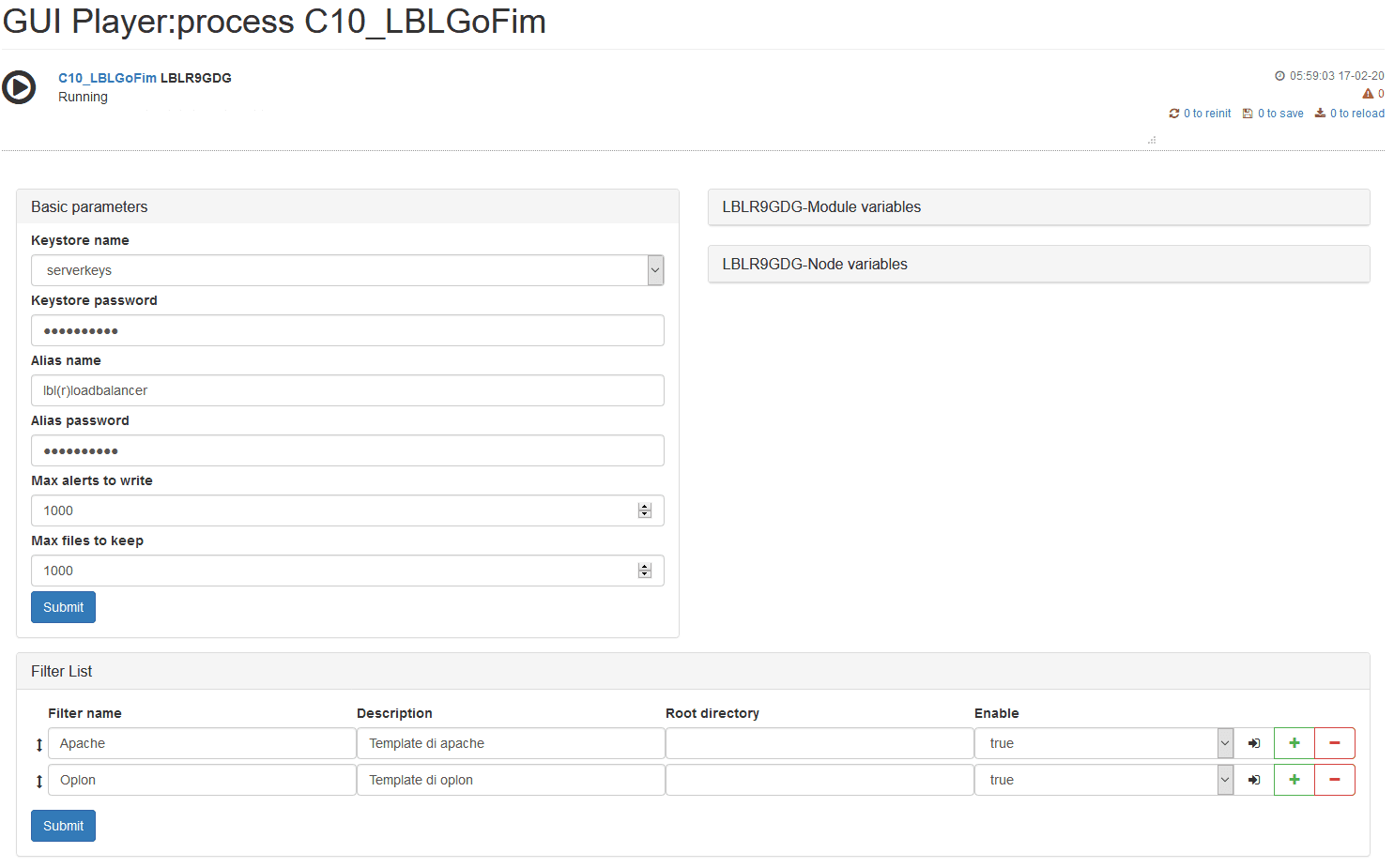
Figure 2: Form
Below are the parameters of the panel Basic Parameters:
- Keystore name: name of the keystore that contains the digital certificate that is used to sign both alert files and database files;
- Password Keystore: keytore password;
- Alias name: identifier name of the certificate within the keystore;
- Password alias: alias password;
- Max alerts to write: maximum number of alerts, files or folders that have information other than that saved in the database, to be written to the alert file;
- Max files to keep: maximum number of alert files and database files to keep on disk.
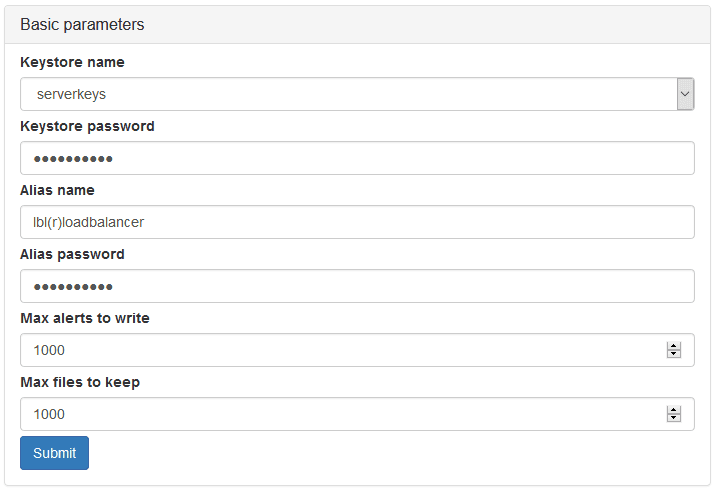
Figure 3: Basic Parameters
Below are the parameters of the panel Filter list:
- Filter name: filter name;
- Description: description of the filter;
- Root directory: folder within which to run FIM, this folder is excluded from the control if you set at least one folder in the FIM panel Directory List which must be a folder inside the root directory; - Enable: enables or disables filtering.
Clicking the see details panel Filters, New10, you will access the filter view.

Figure 4: Filter list
Filter page
This view shows 3 main panels:
- Filter, New10: contains the filter settings in detail;
- Filter, New10 Conditions: contains generic rules for filtering folders and files;
- Directory List: contains all the directories associated with that filter within which to run FIM. So for each filter you can have a list of folders to monitor, which can have equal filtering conditions.
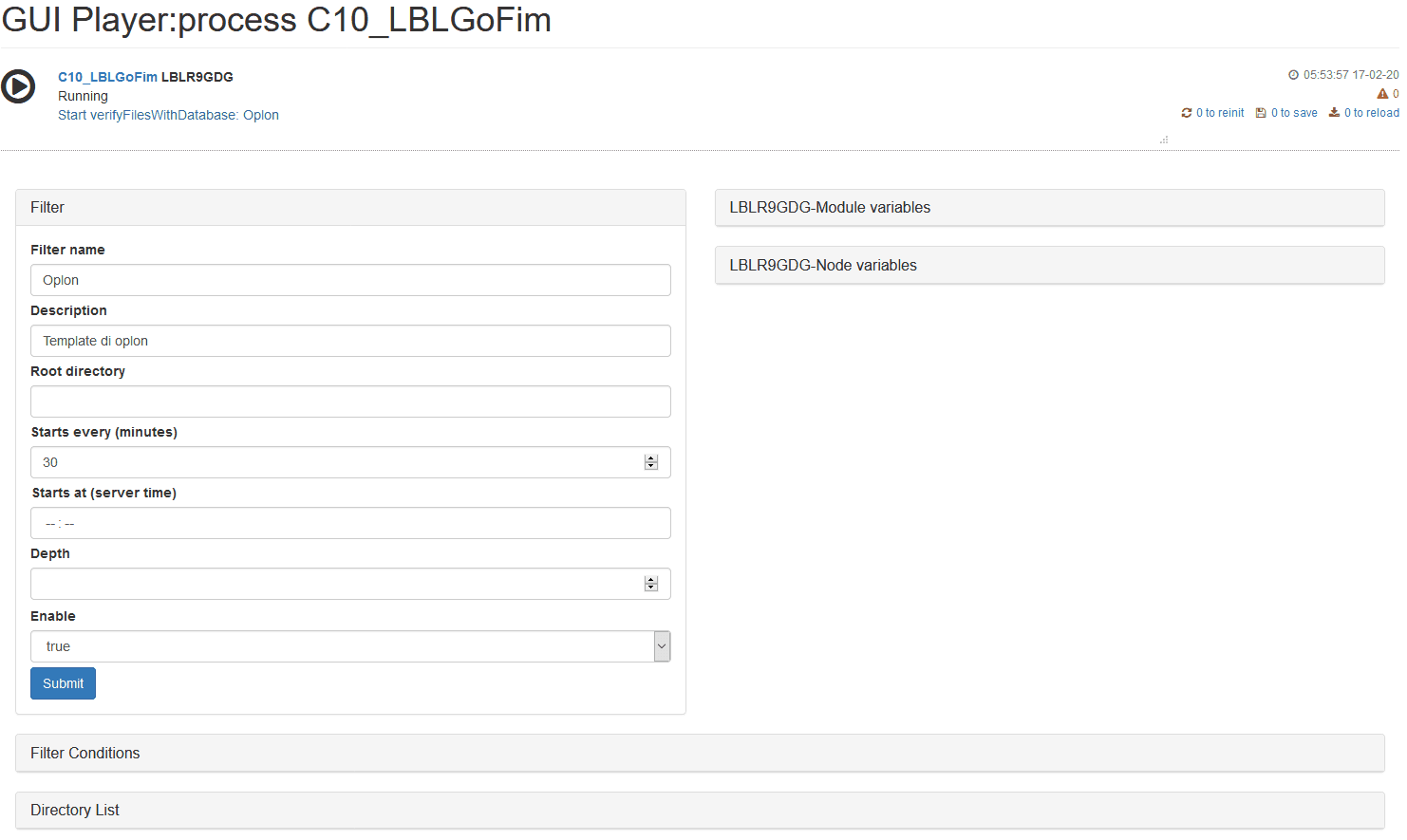
Figure 5: Filter Settings
Below are the parameters of the panel Filter, New10:
-
Filter name: filter name;
-
Description: description of the filter;
-
Root directory: folder within which to run FIM, this folder is excluded from the monitor if you set at least one folder in the FIM panel Directory List which must be a folder inside the root directory;
-
Starts every (minutes): indicates how much to run FIM in minutes, if this field is not empty. Starts at (server time) is not taken into account;
-
Starts at (server time): indicates the time and minutes (in hh:mm format) at which fiM runs every day. If Starts every (minutes) is not empty, this field is not taken into account. Note: The time you entered is the time of the server where FIM is installed, which may be different from the local time;
-
Depth: indicates the depth of the file and folder monitoring, if empty the default value is
2147483647; -
Enable: enables or disables filtering.
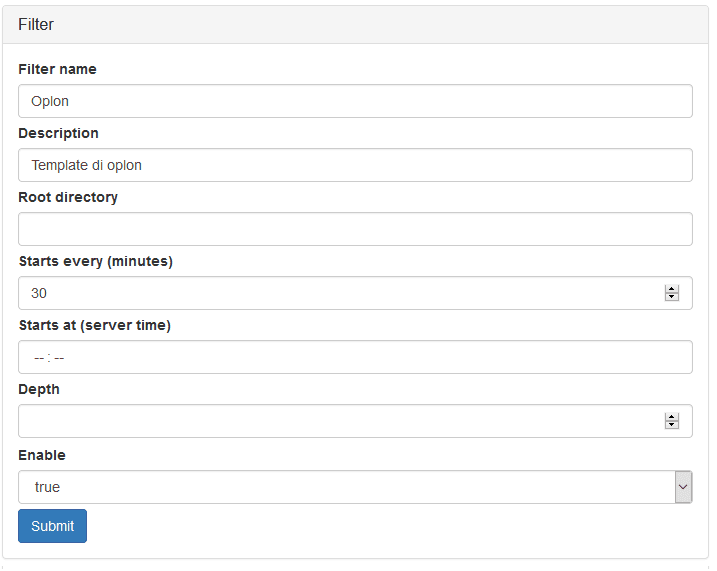
Figure 6: Filter panel
Below are the parameters of the panel Filter Conditions:
-
Operation: list that includes two options:
-
Includes: includes files/folders. If Include is used, only files/folders that meet the rule parameters will be included in the monitor, while all others will be skipped. Includes has higher priority than Exclude, New10, which means that if both are used for the same folder, Exclude, New10 ignored;
-
Exclude: excludes all files/folders. If it is used Exclude, New10, all files/folders that meet the rule parameters will be excluded from monitoring. Exclude, New10 has higher priority than Include, which means that if both are used for the same folder, Exclude, New10 ignored;
-
Type: list that includes two options:
-
file: understand only the files;
-
Directory: understand only directories.
-
Where: list that includes three options:
-
Start: name of the file or folder that begins with …;
-
End: name of the file or folder that ends up …;
-
Regex: regular expression.
-
Value: rule value.
Let’s take an example. If we want to exclude all files that end up in
.log, then the rule will be: Exclude -- File -- End - .log.
If instead we want to include all files that end up in .exe, then the
rule will be:
Include -- File -- End - .exe. However, this means that you will exclude
all files that have an extension other than .exe.
If you want to add new rules, click the following button:
![]() If you want to delete rules, click the following button:
If you want to delete rules, click the following button:
![]()

Figure 7: Filter Conditions panel
Below are the parameters of the panel Directory List:
- Directory name: name of the directory that you want to include in the monitor;
- Description: directory description;
- Depth: indicates the depth of the monitoring of files and folders
within this, if empty the default value is
2147483647; - Enable: enables or disables monitoring on this directory.

Figure 8: Directory List Panel
If you want to add new directories, click the following button:
![]()
If you want to delete directories, click the following button:
![]()
Clicking the see details panel Directory List, you will access the directory view.
Directory page
This view shows 2 main panels:
- Directory: takes back the same information as the panel Directory List;
- Directory Conditions: contains generic rules for filtering folders and files. Resumes the same parameters as the panel Filter Conditions, the only difference is that the rules defined in this panel overwrite those of the filter.

Figure 9: Directories settings

Figure 10: Directory Conditions Panel
NB: The folders within which databases and alerts will be saved are:
- Linux:
/TCOProject/bin/LBL/LBLLoadBalancer_aai_010_000_000/procsProfiles/C10_LBLGoFim/notificationDir- Windows:
C:-TCOProject-bin-LBL-LBLLoadBalancer_aai_010_000_000-procsProfiles-C10_LBLGoFim-notificationDirWithin this path, folders will be created automatically for each
filter:
.../<nomeFiltro/databases and .../<nomeFiltro/alerts.
Conditions
Let’s look in more detail at how Conditions directories.
| Operation | User input | User input norm. | Root + Directory | Directory | Directory norm. | Match |
|---|---|---|---|---|---|---|
| REGEX | (.*)/bb | /var | /var/aa/bbb | /aa/bbb/ | True | |
| STARTS | /aa/bb | /aa/bb | /var | /var/aa/bbb | /aa/bbb/ | True |
| /aa/bb/ | /aa/bb/ | /var | /var/aa/bbb | /aa/bbb/ | False | |
| aa/bb | /aa/bb | /var | /var/aa/bbb | /aa/bbb/ | True | |
| aa/bb/ | /aa/bb/ | /var | /var/aa/bbb | /aa/bbb/ | False | |
| ENDS | /aa/bb | /aa/bb/ | /var | /var/aaa/bb | /aaa/bb/ | False |
| /aa/bb/ | /aa/bb/ | /var | /var/aaa/bb | /aaa/bb/ | False | |
| aa/bb | aa/bb/ | /var | /var/aaa/bb | /aaa/bb/ | True | |
| aa/bb/ | aa/bb/ | /var | /var/aaa/bb | /aaa/bb/ | True |
Operation: indicates the condition that FIM should use to filter folders;
User input: indicates the field Value;
Norm user input: indicates the field Value normalized (an operation that FIM performs during the search);
Root-Directory: indicates the concatenation of the field RootDirectory property with the field FilterDirectory, New1001 it will be used by FIM to normalize the directories it will filter;
Directory: indicates the directory that FIM found within Root-Directory;
norm directory: indicates the directory that FIM found within Root-Directory, normalized (an operation that FIM performs during the search);
Match: indicates whether theuser input normalized matches with the Directory Normalized.
When FIM searches for files, it performs a series of operations to normalize strings passed, as filter conditions, by the user.
-
To normalize the values of Starts, checks whether user input has a slash as its first character, if it doesn’t have it, adds it. With regard to Directory instead, it is normalized by removing, from the path of the directory found, Root-Directory and adding a slash as the last character.
-
To normalize the values of Ends, checks whether user input has a slash as the last character, if it doesn’t have it, adds it. With regard to Directory instead, it’s equal to normalization of Starts.
-
To normalize the values of Regex, user input is not changed, but is normalized Directory in the same way as It starts.
NB: If the user enters the wrong operating system slash (\ or /), FIM
will not correctly evaluate this condition.
The user must enter the path of the directory to be excluded/included
starting from Root-Directory.
Status page
Clicking in the section FIM-FIM Status of the left side menu, the list of currently active filters will be shown, within a table.

Figure 11: Status Page
The following are the attributes of the table displayed:
-
Node: node name;
-
Module: module name;
-
Filter name: filter name;
-
Description: description of the filter;
-
Last Run: date and time of the last run;
-
Prog. files: number of files currently verified;
-
Tot. Files: number of total files to check;
-
Alerts: number of files with issues detected;
-
Starts at: indicates the time and minutes (in hh:mm format) in which fiM runs, every day. If Start at And Start every are not set, by default it will run at midnight each day;
-
Starts every: indicates how much to run FIM, in minutes;
-
Phase: indicates the progress phase of processing;
-
Progress: indicates the percentage of progress of the monitor execution. The progress bar can be two colors:
-
green if there are no alerts;

-
orange if there are alerts;

-
Status: shows the status of the filter, which can be:
-
Running:
 after pressing the start button of the
Actions, or automatically based on the values Starts at And
Starts every;
after pressing the start button of the
Actions, or automatically based on the values Starts at And
Starts every; -
During the stop:
 after pressing the stop button of the
Actions;
after pressing the stop button of the
Actions; -
Waiting:
 if a filter from the same node is
already running.
if a filter from the same node is
already running. -
Actions: set of buttons used to perform actions, which can be:
-
Edit:
 redirects to the filter page in
Figure 5: Filter Settings;
redirects to the filter page in
Figure 5: Filter Settings; -
Start:
 monitors;
monitors; -
Stop:
 stops monitoring that is running.
If you stop it you could not see the alerts until then created (if
any), it depends on the phase of monitoring in which it is stopped;**
stops monitoring that is running.
If you stop it you could not see the alerts until then created (if
any), it depends on the phase of monitoring in which it is stopped;** -
View Alert:
 redirects to the Alerts in
Figure 12: Alerts List.
redirects to the Alerts in
Figure 12: Alerts List. -
Suspend:
 pauses, or
pauses, or
 resumes the processing of alerts. If
paused, no alerts will be considered during monitoring, and therefore
no new alerts (if any) are displayed.
resumes the processing of alerts. If
paused, no alerts will be considered during monitoring, and therefore
no new alerts (if any) are displayed.
Alerts page
After clicking the View alert, you are redirected to a page that shows the alerts (if any) of the last run.

Figure 12: Alerts List
They appear as a table whose attributes are:
-
Node: node name;
-
Moduler: module name;
-
Type: indicates whether the alert shown is:
-
Mismatch file:
 that is, if the file has some
information other than the previous run;
that is, if the file has some
information other than the previous run; -
Mismatch directory:
 that is, if the directory has any
information other than the previous run;
that is, if the directory has any
information other than the previous run; -
New/old file:
 that is, if the file is new or has
been moved or deleted;
that is, if the file is new or has
been moved or deleted; -
New/old directory:
 that is, if the directory is new or
has been moved or deleted.
that is, if the directory is new or
has been moved or deleted. -
Path name: the path where an inconsistency was found;
-
See details: for each row of the table there is a button that, once clicked, will only show the information that has been changed since the last run. You can view 5 types of alerts:
-
Mismatch: only shows information other than the previous run;
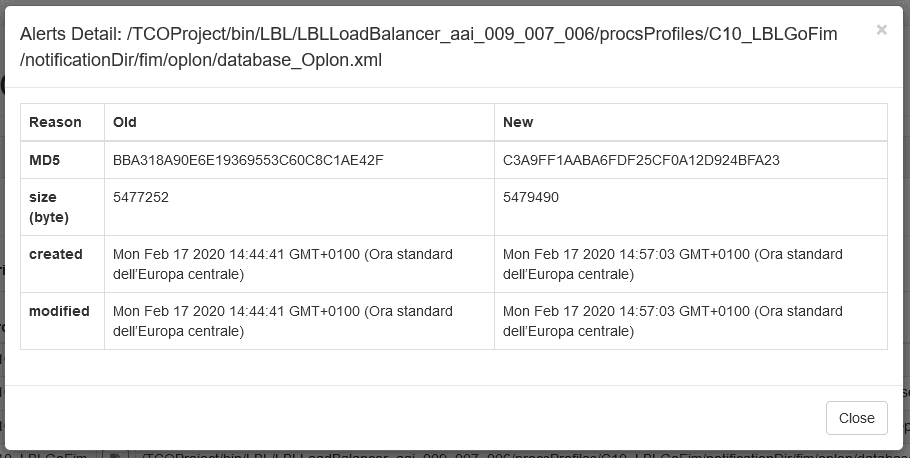
Figure 13: Modal Mismatch
- Max alert exceed: only one alert is shown in the table when the number of alerts created exceeds the maximum limit set in the Max alerts to write.

Figure 14: Max Alert Exceed Alert
If you click View details, the alert details will be shown;

Figure 15: Modal Max Alert Exceed
- New/old: shows all the information of the new or old file/directory indicating whether it is new or old.
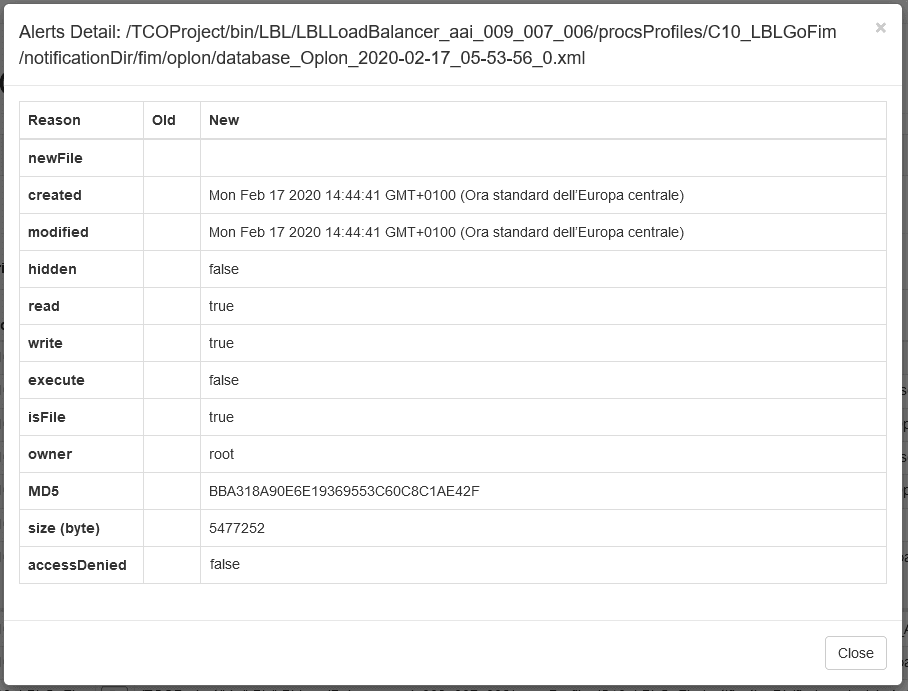
Figure 16: Modal New/Old
If you click View details, the alert details will be shown;
- Firm failed: the alert is shown in the table when a file signature is incorrect.

Figure 17: Firm failed
If you click View details, the alert details will be displayed.

Figure 18: Modal firm failed
If you want to view all file or directory alerts that are contained in
the parent directory of one of the paths in the list, just click on the
column icon Type property, of that path.
Example:
Path name: A/B/C/file.txt
If we click the icon for this file, the full path will be written to the
table search bar, excluding file.txt, and then only the alerts of files
and folders that have as Path name A/B/C.
Templates
There are templates inside the panel Filter list can be modified to suit your needs.
The available templates are: Apache, MySQL, Tomcat, Nginx, Jboss.